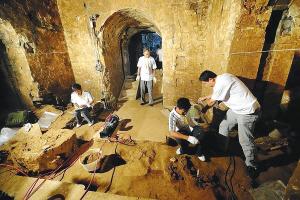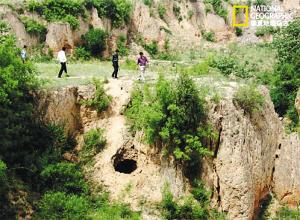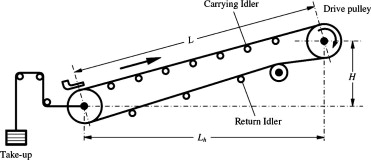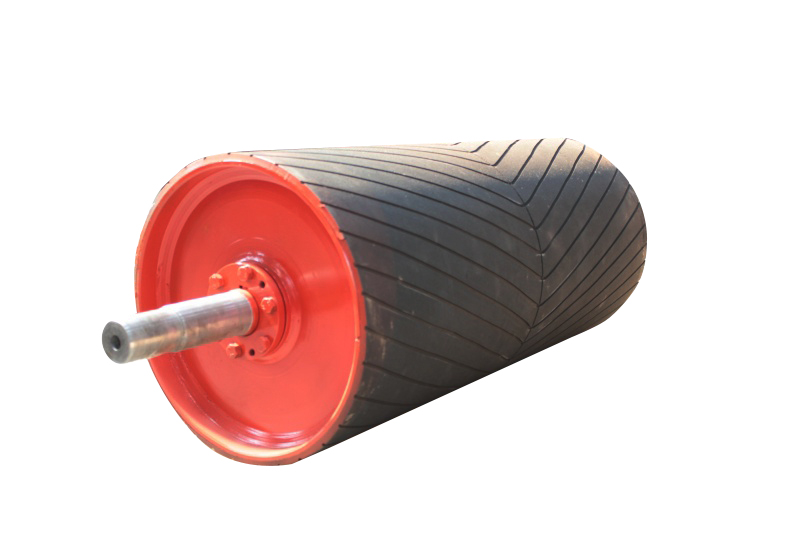
The tomb tools seized from the graves of the Hancheng tomb in Shaanxi include shovels, ropes and Luoyang shovels of different sizes.

Cao Cao’s tomb has been entered by robbers numerous times.

The Hancheng Tomb in Shaanxi was once ravaged by robbers and has been surrounded by barbed wire for four weeks. The preservation of the Hancheng Tomb is inseparable from the active protection of local villagers. Local villagers spontaneously formed patrols after they discovered the caverns. (This version of the picture is a profile picture)
The ancient tomb is the final fixed frame of the end of life, and it is also a repository for storing several cultural information in the era of the tombs. Overlapped ancient tombs have undergone many changes and are often destroyed for various reasons. The most common forms of destruction are intentional robberies. Tombs in history are quite common. They have even become local customs in certain regions and have become a means of making a living for certain families. They have become the characteristics of certain social groups.
Since the 1990s, the tombs of the tombs in China’s mainland have become increasingly fierce. From Central Plains to Guanzhong, to Jianghuai, they have spread almost all over the central regions where ancient Chinese culture originated. As long as there are ancient tombs throughout the country, there are tombs of tombs. In fact, the tomb phenomenon is not just happening in China. Tombs are an international disaster.
Ancient Tombs have different motives
Tombs are ancient social cultural phenomena. Archaeological data of the Neolithic Age can already see the remains of conscious tombs. In the Spring and Autumn Period, after the social change of “ritual badness and music collapseâ€, the thick burial winds began to rise, so the behavior of tomb robbing was prevalent.
In ancient China, tombs had even become common practice in some regions and became a means of family farming. Li Shangyin of the Tang Dynasty once said in the volume of the “mixed recipes†he wrote about “evil bankersâ€, the second of which was “generation graves.†It can be seen that the behavior and technology of professional robbers are often inherited from generation to generation.
"Zhu Xing Heng Yan" volume fourteenth, "Niu Fan Lou and Passionate Zhou Shengxian" describes Zhu Zheng's tomb story, and can also see the inheritance relationship of the child's step-father industry.
The most common mob mob’s motive was to rob the tomb’s funerary objects. The emperor Jin Ren once pointed out that “Feng Cai's thick burial was to launch a traitor, or to cut a scorpion, or to carry a plague, or to remove a ring, or to make a gut for a jadeâ€. Grave martyr’s relentless destruction of tombs and extreme insults to the dead are largely due to the treasure’s “desireâ€.
In addition, excavation of grave tombs of political opponents and political opponents has been used as one of the most powerful means of dissatisfaction with each other in ancient Chinese power struggles. Digging graves is also a form of political punishment and political persecution. After Tang Ruizong was enthroned, Wu Sisi, Wu Chongxun and his son, Taiping princess, Wei Xuanzhen and Wei Wei and his son, who once belonged to the hostile political group, all used tombs as a form of political punishment. In the Song Zongzong Shao Shengsheng period, Sima Guang, who was in power during the Yuanyou period, and his policies were negated. It was suggested that the tomb of Sima Guang be discovered. "Yuan Shi and the Traitors of the Apostle" wrote that after the death of A Hema, the Yuan Shizu "does his sins," and he is furious. "It is the fate of the fatal fate, and the corpse is outside the Tongxuan Gate. Its flesh, princes and princes, gather to watch it quickly."
If we analyze the psychological motives of the destruction of ancient tombs, we can also find special factors based on mysticism. "The Story of the Three Kingdoms, Wu Shu, and the Three Scorpions, Sun Chuan" quoted the "Han, Jin and Chun Qiu" story of such a digging to be irritating, and the hopeful Qi said that "Jingzhou has a kingly spirit," and Wu Zhusun was suspicious of the local king. The dominance of tyrants is not conducive to its rule. "The ambassadors have given birth to the famous officials in Jingzhou."
Although the ancient tomb robbers had various motives and some were even the "official" behaviors of the military participation, they did not mean that the tombs could do whatever they wanted in ancient times. In fact, many ancient dynasties in China had banned tombs on the tombs. Such laws appeared as early as the Qin period. "Lu's Funeral of the Spring and Autumn Annals," wrote that thick funerals formed a style of habit, and therefore induced the behavior of the rapist tomb. "Although the ban on the severe sin of Yan Wei, it can never stop." The Han Dynasty banned the tomb of the law, but also found histories. The laws of the Tang Dynasty included the content of the sanctions against the tomb. "The Law of Tang Dynasty" has a clear stipulation on the punishment for "fathers": "The people who send shackles are to be punished, and those who have been shackled; The Old Tang Dynasty Book of the Song Dynasty records that the “grabbing of graves†is the same as “every evil, rebellion, official guilty, intentional homicide, co-produced poison, igniting fireâ€, and “relationship†and “inverse partyâ€. One of serious sins. The "Great Qing Laws" punished 36 cases of related tombs. There are as many as 22 regulations and their contents are extremely detailed.
Today's tomb is the word
What causes the tomb phenomenon to be enduring? Does it have a direct relationship with ancient Chinese culture? Prof. Li Shan, an expert on ancient cultural history at Beijing Normal University, pointed out: “The swindle of treacherous treasures is inseparable from traditional Chinese thick burial customs. In class society, Thick burials have become common practice."
The ancient Chinese people expressed respect for the king and filial piety, but they also had to face. A thick funeral can satisfy these kinds of mentality. "Lu's Spring and Autumn Anniversary Funeral" records that at that time people often used some special items that could show their status and status, as well as a large amount of living materials and rare and beautiful things. Later generations were also proud of it. As the saying goes, "If you want to bury it for extravagance, then your heart is not for the sake of the dead.
The author of "The History of China's Tomb of Tombs" and the researcher of the History Department of Beijing Central Party School studied princes at the Northwestern University in the late 1970s. He once visited the excavation site of the No. 1 Cemetery at Qingong, Fengxiang, Shaanxi. He said that standing in the graves that the archaeological team was digging, he saw 247 blunders with dense soils and soils that were significantly different from the surrounding burial soil and really felt the thrill of ancient tomb activities. This tomb is the tomb with the most cave-ins known to date. The age of excavation continued from the Han Dynasty to Tang and Song. In the final stage of the excavation of the tomb, the prince also participated in some of the on-site work and saw that there were more than a dozen stolen holes that had hit the dormitory.
The disturbance and destruction of archaeological work by Tomb Raider is not only caused by the many tombs that were lost during the looting, but also because ignorant robbers often choose only according to the market value scale. Some of them are not necessarily valued by antique traders, but they are extremely important. Cultural artifacts of scientific value and cultural value were destroyed. In addition, the significance of the tombs for archaeological work is not merely manifested in the quantity and quality of the funerary objects, the form of tombs, the burial form, etc., which do not appear to have direct commercial value. In fact, they all contain very important historical and cultural information. Barbarous robberies often cause irreparable damage to these phenomena. The grave tombs have caused serious damage to the archaeological work and still have obvious manifestations. Some very important cultural relics were excavated because of the excavation. The site of discovery and other related relics are still unclear. The archeological value cannot be realized, so that the scientific archaeological work may have played an important role in understanding ancient social history. The data cannot play a role. These are all deeply saddening people who care about and love Chinese history and culture.
The famous archeologist Li Boqian pointed out that according to incomplete statistics, the theft rate of our royal-class tombs was over 90%. They include the Yanguo cemetery in Fangshan Liuli River in Beijing, the Qiuguo cemetery in Sanmenxia, ​​Henan, the Jinhou cemetery in Houma, Shanxi, the Qiuguo cemetery and Zhougong cemetery in Hancheng, Shaanxi, and the Qiguo Guojun graveyard in Shandong.
Since the 1990s, the tombs in China’s mainland have become increasingly fierce. From Central Plains to Guanzhong to Jianghuai, the provinces involved include Shanxi, Gansu, Qinghai, Xinjiang, Hubei, Hunan, Shandong, Sichuan and Jilin. Hebei, Henan, Anhui, and so on, almost all of the central regions where ancient Chinese culture originated. As long as there are ancient tombs throughout the country, there are tombs of tombs. It is understood that about 100,000 robberies are scattered throughout the country, which has constituted a point selection, robbing, and selling one-stop graves.
In fact, the tomb phenomenon is not just happening in China. Tombs are an international disaster. Houghton, a senior adviser to UNESCO, once pointed out that the amount of cultural relics on the ground and underground in the world is second only to the high profits of the drugs and weapons trade. In China, India, and Egypt, where three major cultural relics are exported, China has almost everything that tomb fighters need in the global tombs. The exact statistics show that of the 218 museums in 47 countries, there are 1.63 million Chinese artifacts, and this number is only one-tenth of all private collections in the world. The loss of cultural relics from major cultural relics in China, Egypt and Greece is on the rise. In China, the proportion of stolen tombs is close to 100% in all the drained cultural relics in China.
Only heavy code or can protect ancient tombs
China's tombs are rampant and they are also quite "professional." "Tombs are more professional than archaeological ones." Horses known for their collections did not "do business" when they spoke in Wuxi because he avoided the old line and instead picked up a "grave tomb." When it comes to the Mawangdui Mausoleum in Henan, the collector said that the archaeologists had originally stated that “no tombs were buried here†but the two tombs confirmed the “big treasureâ€. . As a result, the two decided to stay awake and secretly explore. One morning, two elderly ladies who had exercised in the morning were occasionally passing to see the new soil on the cemetery loose and reported to the police. They then caught him. The thieves did not cooperate and soon explained the situation, after which archaeologists began to participate in the excavation. "It was a tomb before. Now it is archeology. The thieves also made guides to participate in the archeology. There are foundations where the thieves threw them. The archeologists went in with a hammer!"
According to the personage concerned, according to the division of labor, the people in the tomb circle have different titles: "eyes", "brick", "legs" and "bitter." The one-stop operations such as digging, transporting, harboring and selling are accomplished by these roles. In general, the whole class of the graves has a unified title called "one pot." The highest level in the pot is called the "palm eyes" and is the central figure in this pot. "The palm eye" not only has the ability to find ancient tombs, but also has the ability to identify cultural relics. They can either be collaborators who provide ancient tomb clues, or they can be junior buyers who plan to purchase artifacts from the tomb.
“Tangguo†is the person responsible for every excavation activity, similar to the contractor's contractor who is responsible for raising funds and equipment required for the tomb-raising operation. The investment of “brick†is risky, and once the excavated artifacts are not purchased, he can only handle it on his own. "Legs" refers to the technical workers in the tomb activities. They play the role of "project manager" in the process of robbing the tomb and are responsible for exploring the specific location of the cemetery and determining whether there are any artifacts inside.
Tombs have already formed teamwork, and the tombs have been semi-publicized in many places; how to solve the issue of tombs? The experts call for the implementation of the “Army Accountability Protection System†to be implemented, but also to restore the sentence of the death of criminal tomb crimes.
The official implementation of the amendment to the criminal law, "the crime of excavation of ancient sites and ancient tombs" was listed as one of the 13 economic non-violent death penalty charges. In response, Liu Qingzhu, former director of the Institute of Archaeology at the Chinese Academy of Social Sciences, said that he was "very wrong." He said that in defining the crime of excavation of ancient tombs, using it as a "non-economic violence" crime is inconsistent with the facts. As regards the excavation of ancient tombs as "non-violent" crimes, it is also seriously inconsistent with the objective facts. Now robbers thieves use explosives to open burglars, and many robbers thieves are “armed†robbers. How is this “non-violence� Liu Qingzhu believes that it is not appropriate to recognize the excavation of ancient tombs as “non-violent†and “economic†crimes.
Tomb wickedness is a brutal blasphemy of the civilization history of the Chinese nation for thousands of years. It is a brutal plunder of precious underground artifacts. It can be described as madness and sin is not tolerable. Only heavy code may be able to scare off the tombs and protect the ancient tombs.
A driving pulley, in particular, is a powered wheel and axle that moves a conveyor belt. Also called belt conveyors, a conveyor belt is a loop of material that runs between two or more pulleys: drive pulleys and idlers. The purpose of conveyor belts is to move objects along the belt to another location. In the conveyor belt system, a drive pulley has power applied to it and an idler is a pulley that has no power. The drive pulleys will cause the belt to move toward them, while the idler pulley simply turns over and allows the belt to move. The power can be derived from a motor or can be provided by hand. The larger the materials or goods that are moved by the conveyor built the pulley is powering, the stronger the motor or other power source will need to be that drives the drive pulley.

A pulley is one of the six simple machines, along with an inclined plane, lever, wheel and axle, wedge and screw. The belts operated by drive pulleys typically have two or more layers and are usually made of rubber. The inside layer is the strong layer, called the carcass, that is next to the pulley, and the outer layer is called the cover. For strength, the carcass is usually made of cotton or plastic mesh and the cover is rubber or plastic.
Spherical Roller Bearing are available with heavy duty rollers and cages that are suitable for extreme demand harsh applications such as vibratory screens.

Main Models:
Spherical Roller Bearing
Series 222.., 223.., 230.., 231.., 232.., 239.. 240.., 241.., CA/CC/W33
To be the first class, to do the best quality, to make users satisfied, to ensure customers relieved, are our enterprise purposes. Welcome bearing dealers` and Conveyor Idler manufacturers contact from all over the world, and become our partner.
Driving Pulley,Light Duty Driving Pulley,Heavy-Duty Driving Pulley
Shandong Xinkaite Bearing Co., Ltd. , https://www.idlerbearing.nl